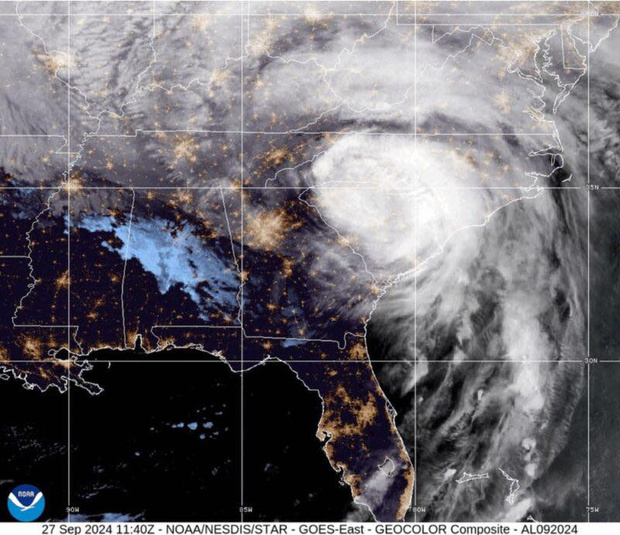
Colorado State University hurricane researchers are predicting another above-average Atlantic hurricane season in their initial 2025 forecast.
And they say current global weather conditions headed into this season are very similar to memorable years of tropical activity on the Outer Banks and in eastern North Carolina from over the last four decades.
The team at CSU is predicting 17 named storms during the Atlantic hurricane season, which runs from June 1 to November 30, according to their report released Thursday morning at the National Tropical Weather Conference in South Padre Island, Texas.
Of those, researchers forecast 9 to become hurricanes and 4 to reach major hurricane strength (Saffir/Simpson Category 3, 4 or 5) with sustained winds of 111 miles per hour or greater.
So far, the 2025 hurricane season is exhibiting characteristics similar to 1996, 1999, 2006, 2008, 2011 and 2017, said Phil Klotzbach, a senior research scientist in the Department of Atmospheric Science at CSU and lead author of the report.
Those years are notable for the back-to-back landfalls by hurricanes Bertha and Fran in 1996 near Wilmington, Tropical Storm Dennis followed a week later by Hurricane Floyd that caused record rainwater flooding across interior sections of eastern North Carolina in 1999, and Hurricane Irene’s massive soundside/coastal river storm surge in 2011 from Hatteras Island all the way up to and beyond state line.
“Our analog seasons ranged from having slightly below-average Atlantic hurricane activity to being hyperactive,” said Klotzbach. “While the average of our analog seasons was above normal, the large spread in observed activity in our analog years highlights the high levels of uncertainty that typically are associated with our early April outlook.”
CSU’s Tropical Cyclones, Radar, Atmospheric Modeling and Software Team within the Department of Atmospheric Science cites above average subtropical eastern Atlantic Ocean and Caribbean Sea surface temperatures as a primary factor for their prediction of nine total hurricanes this year.
When waters in the eastern subtropical Atlantic are much warmer than normal in the spring, it tends to force a weaker subtropical high and associated weaker winds blowing across the tropical Atlantic.
These conditions will likely lead to a continuation of above-average water temperatures across most of the tropical Atlantic for the peak of the 2025 hurricane season. A warm Atlantic favors an above-average season, since a hurricane’s fuel source is warm ocean water.
Additionally, a warm Atlantic leads to lower atmospheric pressure and a more unstable atmosphere. Both conditions favor hurricane formation.
While the tropical Pacific is currently characterized by weak La Niña conditions, these are likely to transition to El Niño-Southern Oscillation (ENSO) neutral conditions over the next couple of months.
There remains considerable uncertainty as to what the phase of ENSO will be during the peak of the Atlantic hurricane season from August to October. However, the odds of El Niño are quite low (13% per the latest NOAA outlook). El Niño – a recuring climate pattern – tends to increase upper-level westerly winds across the Caribbean into the tropical Atlantic.
These increased upper-level winds result in increased vertical wind shear, disfavoring Atlantic hurricane formation and intensification.
The absence of these conditions, as we anticipate this year, is generally associated with hurricane-conducive upper-level wind conditions across the tropical Atlantic.
Given the combined hurricane-favorable signals of a warm Atlantic and the unlikelihood of El Niño, the CSU forecast team is predicting an above-normal season.
The authors do note that the initial April forecast historically has the lowest level of skill of CSU’s operational seasonal hurricane forecasts, given the considerable changes that can occur in the atmosphere-ocean between April and the peak of the Atlantic hurricane season from August to October.
The team bases its forecasts on a statistical model, as well as four models that use a combination of information and predictions of large-scale conditions from the European Centre for Medium-Range Weather Forecasts, the UK Met Office, the Japan Meteorological Agency and the Centro Euro-Mediterraneo sui Cambiamenti Climatici.
These models use 25 to 40 years of historical hurricane seasons and evaluate conditions including variables such as: Atlantic sea surface temperatures, sea level pressures, vertical wind shear levels, the El Niño phenomenon and other factors.
The team predicts that 2025 hurricane activity will be about 125% of the average season from 1991–2020. By comparison, 2024’s hurricane activity was about 130% of the average season.

The most significant hurricanes of the 2024 Atlantic hurricane season were Hurricanes Helene and Milton, which combined to cause over 250 fatalities and more than $120 billion dollars in damage in the southeastern United States.
In addition to the various hurricane metrics that CSU has used for many years, the forecast team introduced a new metric in 2023.
Accumulated Cyclone Energy (ACE) occurring west of 60 degrees west longitude is an integrated metric accounting for storm frequency, intensity and duration in the western half of the Atlantic Basin.
ACE generated west of 60 degrees west correlates better with landfalling storms in the Atlantic basin than basinwide ACE, since virtually all hurricane-prone landmasses in the Atlantic Ocean are located west of 60 degrees west.
Generally, a slightly lower percentage of basinwide ACE occurs west of 60 degrees west in El Niño years relative to La Niña years. Since the team anticipates either neutral ENSO or La Niña as the most likely outcome in 2025, the percentage of basinwide ACE occurring west of 60 degrees west is predicted to be relatively high in 2025.
The CSU team will issue updates to their forecast in June, July and August, while researchers at N.C. State University and NOAA forecasters will issue their predictions in the coming weeks.
This is the 42nd year that CSU has issued an Atlantic forecast. The late Professor Emeritus Bill Gray originated the seasonal forecasts at CSU and launched the report in 1984. He continued to author them until his death in 2016.
The authors of this year’s forecast are Phil Klotzbach, Professor Michael Bell and Research Scientist Levi Silvers.
The CSU Tropical Cyclones, Radar, Atmospheric Modeling and Software Team is part of the Department of Atmospheric Science in the Walter Scott, Jr. College of Engineering at CSU and is one of the top ranked atmospheric science programs in the world.
The CSU forecast is intended to provide a best estimate of activity in the Atlantic during the upcoming season, not an exact measure, and the researchers caution coastal residents to take proper precautions, said Bell.
“It takes only one storm near you to make this an active season for you,” he said.
Hurricane landfalling probability included in 2025 report
The report also includes the following probability of major hurricanes making landfall in 2025:
- 51% for the entire U.S. coastline (average from 1880–2020 is 43%).
- 26% for the U.S. East Coast, including the Florida peninsula (average from 1880–2020 is 21%).
- 33% for the Gulf Coast from the Florida panhandle westward to Brownsville, Texas (average from 1880–2020 is 27%).
- 56% for the Caribbean (average from 1880–2020 is 47%).
The forecast team also provides probabilities of named storms, hurricanes and major hurricanes tracking within 50 miles of each county or parish along the Gulf and U.S. East Coast, as well as hurricane-prone coastal states, Mexican states, Canadian provinces and countries in Central America and the Caribbean.
These probabilities for regions and countries are adjusted based on the current seasonal forecast.








